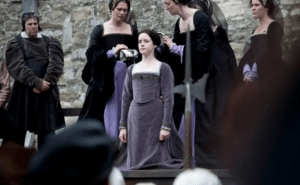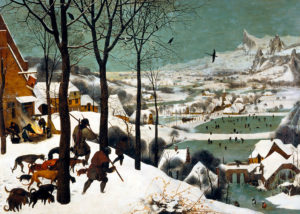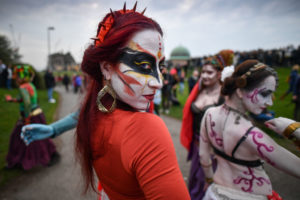Seattle-based Bri Luna, aka @thehoodwitch, has 472,000 followers on Instagram. On her website, thehoodwitch.com, her profile picture shows an attractive young woman wearing a black dress that reveals both tattooed cleavage and one tattooed thigh, holding a crystal ball in a ring-bedecked hand. The image is fiercely sexual and deliberately powerful, but this is a power that is linked to magic, which, she says, is open to all who choose to claim it: “The universe is vast, and we need as many healing information sources as possible. It is time for us to awaken and tap into the deepest parts of ourselves and into the natural magic that is offered to us by this very planet we inhabit.”
Bri Luna is a magical influencer, whose posts appeal to the increasing number of people — especially young women — who self-identify as witches, and who account for the 6.8 million Instagram posts with the hashtag #witchesofinstagram. It’s clear that many of those posting use it simply to attract attention to their hot Goth selfies; to interior design ideas with not-much-of-a-twist — “Last Minute Beltane Ideas … place a bouquet of fresh flowers in your home. Light a red (passion) and a white candle (purity) [sic]. Decorate your home with ribbons and flowers…”; or to promises of a miracle — “Any Finger That will like this will never lack of money” (though they may lack of grammar).
On TikTok, witches are even more popular: witchtokboy, who offers spells and curses, has had 8.2 million likes and offers bookings. But it’s not just a digital phenomenon — Taylor Swift’s latest album, Evermore, has seen witches welcome her to their tribe. In the last few years, witchcraft manuals, such as Ariel Gore’s 2019 Hexing the Patriarchy: 26 Potions, Spells and Magical Elixirs to Embolden the Resistance, have been published in number and sold well. Gore writes that “magic has always been a weapon of the disenfranchised” and promises to teach her readers how to make “salt scrubs to wash away patriarchal bullshit” and “mix potions to run abusive liars out of town.”
Elsewhere, self-identifying witches have become political, like the protestors in Boston in August 2017 who dressed as witches and carried signs saying, “Witches against White Supremacy”, “Hex White Supremacy”, “Good Night Alt-Right”, and — note the acronym — “We Interrupt Those Choosing Hate”. Some of this has been taken very seriously: when, in February 2017, Michael Hughes posted online “A Spell to Bind Trump and All Those Who Abet Him” and urged other witches to join him in casting it, Christian Trump supporters put out urgent calls for prayer and fasting to counter the spell.
Having studied the witch-hunts of the 16th and 17th centuries, I find this resurgence both fascinating and a little disturbing. Historically, people turned to magic when things felt uncertain or inexplicable. They were more likely to accuse their neighbours of witchcraft in times when money was tight or disease was rife. And while men could be and were accused of witchcraft, in most places in Europe women made up the vast majority of those who were prosecuted and executed as witches, because women were perceived to be innately weaker and more sinful than men, and so more easily tempted by the Devil.
In a culture fixated on fecundity, older women were especially vulnerable to accusation, because the witch was seen as infertile, an anti-mother. Above all, it was the idea of magical, diabolical power being used by the socially powerless that made witches especially scary. In today’s world, when money is tight, disease is rife and many people feel politically impotent, the resurgence of witchcraft among young women is both a mark of powerlessness and an attempt to reclaim power.
Professor Ronald Hutton suggests that the word “witch” was once used as a kind of smear campaign for all types of folk magicians. Many names that were originally insults — Protestant, suffragette, sans-culotte, queer — have been reclaimed, and that seems to be happening again as, for many modern sorceresses, “witch” has become a synonym of “feminist”. Much of the identification comes from seeing the history of the witch-hunts as a story of female oppression. Modern-day witch Gabriela Herstik told Sabat Magazine that “Witchcraft is feminism, it’s inherently political. It’s always been about the outside, about the woman who doesn’t do what the church or patriarchy wants.”
She is echoed by April Graham, whose sweep is even broader: “A Witch is somebody who stands against patriarchy and everything that is currently wrong with our society and any society throughout the ages.” By that definition, we could all be witches — which may, indeed, be the point; Luna says, “Every woman is a Witch.”
Witchcraft, then, has been repackaged as a kind of female empowerment. Erica Feldman, the proprietor of HausWitch shop in Salem, Massachusetts, says that for her the initials WITCH stand for “Woman In Total Control of Herself”. Deborah Blake, author of Modern Witchcraft: Goddess Empowerment for the Kick-Ass Woman (2020) gives away her stance in the title, but adds that “Many women are feeling frustrated, frightened, triggered, and down-right furious with the current social and political environment, but also feel powerless to create positive change … Witchcraft can give them both a sense of personal empowerment and a number of goddesses through whom they can channel those feelings in healthy and productive ways.”
Though not always. There is a burgeoning genre of books on how to hex your ex, including Deborah Gray and Athena Starwoman’s How to Turn Your Ex-Boyfriend into a Toad and Other Spells. You can feel the fun they had composing these: ingredients needed for “The Forget Me Not Spell” are “a square of white cloth, a sprig of mint, a photograph of you and your lover together, a pair of your lover’s underpants, a pair of your sexy underpants, a piece of scarlet ribbon”. The Toad Spell needs to be done at midnight on a Full Moon and involves making a cloth bag, filling it with dirt and a picture of your ex, and drawing a toad on it. If you can’t draw, you can probably find someone on Tiktok to cast a spell for you. This is the commodification of witchcraft.
Some of the modern elision between witchcraft and feminism, however, has a less capitalist edge. The notion of using the figure of the witch to fight patriarchy has roots in the 1960s American women’s liberation group W.I.T.C.H. — Women’s International Terrorist Conspiracy from Hell — who protested societal inequalities by dressing up as witches, “hexing” Wall Street, and gluing shut the doors to the New York Stock Exchange — but they were using the term with their tongues conspicuously in their cheeks: they didn’t consider themselves to be “real” witches.
Instead they adopted the name because they believed accused witches of the past were “the original guerrillas and resistance fighters against oppression — particularly the oppression of women down the ages” (WITCH manifesto, 1969). The group was revived in 2015-16 and its modern iteration takes its witchiness much more seriously. Its founding members, who all identify as witches, staged a ritual performance to focus attention on the lack of affordable housing in Chicago. One of them, Jessica Caponigro, objects to being called a “witch” in inverted commas, and resents threats from Wiccans who don’t think her witchy enough. She considers witchcraft to have always been “an act of social protest.”
In this reading, witches were always activists, rebels and non-conformers, who were punished for the resistance they mounted to the patriarchy. In the women’s marches of January 2017, protesters wore T-shirts, pin badges and placards bearing the line (from Tish Thawer’s 2015 novel The Witches of BlackBrook): “We are the granddaughters of the witches you weren’t able to burn” (even though, in England and New England, witches were hanged). Witchcraft has become a signifier of both systematic violence against women and of women’s attempts to resist that violence. This creates a binary of “we” — the assumed descendants of the oppressed — and “you” — the assumed oppressor.
This involves holding two dissonant ideas in tension: witches are women who exploit their power, and magic is something used by those who have no power. It is worth noting that neither aligns with the historic reality of the European witch-hunts in which large numbers of powerless, innocent people were prosecuted, tortured and executed — by which I mean that most of the witches accused in the 16th and 17th centuries protested that they were not guilty because they had not used magic. To believe witchcraft is making a comeback, you have to believe it was around in the first place. But today’s witches do, and they believe in both using and celebrating their supernatural powers. But here’s the rub: do they claim to actually practise magic?
Much hinges on our definition of the word. Witches in the past were thought to practice maleficium or evil magic that caused harm to people, animals or property, but Professor Hutton suggests we need a broader definition of magic that includes “any formalised practices by human beings designed to achieve particular ends by the control, manipulation, and direction of supernatural power or of spiritual power concealed within the natural world.” Witchcraft today seems to be about accessing supernatural power without faith in a deity. It promises to tap into unseen sources of power as a way to tackle life’s problems. Luna claims that witchcraft offers “resources for collective healing in our fraught political and social climate.”
But what does this magic look like? There is normally mention of the sort of things you might expect: Juliet Diaz, whose 2018 book Witchery: Embrace the Witch Within was an Amazon bestseller, describes a “Magick” that includes herbs, working with lunar cycles and the solar year, and setting up a sacred space. Others mention shrines, crystals, tarot cards, astrology, reiki, and auras. But there’s much that emulates Rhonda Byrne’s The Secret – that the universe will yield up its bounty in response to repeated affirmations. I’ve seen a spell defined as “a prayer to the universe”.
Diaz offers a “manifesting spell”, for example, for which you need a bay leaf, some matches, a pen (she recommends menstrual blood as ink), a burn-safe bowl or cauldron, and some plant seeds (perhaps sage, eucalyptus or mint). Then: in a place of stillness, repeat aloud your desire as an affirmation (“I am blessed, money flows into my life easily and effortlessly”), and write the affirmation on the bay leaf before burning it in the bowl and planting the ashes with the seeds. Elsewhere magic is presented in the language of self-care – aromatherapy and meditation feature frequently. Magic is aligned with accessing what Luna calls “the deepest parts of ourselves”, Diaz’ “witch within”.
“Natural magic” — what Hutton referred to as the direction of “spiritual power concealed in the natural world” — also seems to play a major part. Here witchcraft manuals overlap with another genre of books that have boomed in sales as the young feel more politically powerless: books about getting back in touch with the world around you and reconnecting with nature.
Dr Alice Tarbuck’s A Spell in the Wild: A Year (and Six Centuries) of Magic (2020) — a beautifully-written meditation for the urban witch — seems to speak of magic where other words might do. Her “healing ritual for winter pains” is an affirmation of the healing power of food. Her euphemism for masturbation — “solitary sex magic is a way of observing the energy of witches’ Sabbats” — made me laugh out loud. But there is much that is metaphorically enchanting about the way she comprehends magic to be about connecting with the earth and attuning oneself to nature.
“Witchcraft is,” she writes, “I believe, the practice of entering into relation with the world, of exerting your will in it and among it, and learning how to work with it in ways that are fruitful for yourself and the world.” The warm, lyrical, and tender tone of her writing wins her many five-star reviews, but you don’t need to be a witch to wonder with her at “the curious magic of the world, the way it shimmers and changes if you walk through it … with your eyes open”. So why do she and others think that you do?
I think the rise in people identifying as witches might come from a combination of factors: not only does witchcraft promise you the mystical power to change your life, but in the same breath calling oneself a witch claims a victim status — as part of a historically downtrodden minority — and offers a reassuring place in the world: membership of a community with a shared language, set of rituals, and an identity. It provides the comforting framework of religion for the non-religious and a fellowship of believers for the unbeliever, and it does so in a very capacious way, as befits an age of identity politics. “Witch” and “witchcraft” have become such all-inclusive, amorphous categories that they can mean anything and everything — and sometimes even nothing.
This mantra is repeated again and again: Diaz states that “A Witch can’t be defined, because a Witch is an embodiment of his or her own unique Magick.” Caponigro argues that “There is no right way to be a witch. If you say you are a witch, and feel you are a witch, you are a witch. End of story.” That there is no definition, no criteria, appears to be a major part of the appeal. Being a witch is conceived, as Luna puts is, as “the freedom to be your most authentic self. To embrace ALL aspects of whoever that may be, and fiercely.” Diaz is even more startingly postmodern: a witch is “an embodiment of her truth in all its power”. Being a witch is whatever you want it to be, as long as it is self-actualising. Focusing on the self is legitimated by the language of healing nature and scaring the patriarchy.
In the European witch-hunts, witchcraft was invoked in times of poverty or pandemic, when people felt disenfranchised, and when things seemed inexplicable, and it chiefly concerned women. For similar reasons it is being invoked today (humans, universally, it seems do not cope well with the brutal unfairness of the concept of chance). But those characteristics in early modern Europe caused people to accuse their neighbours of witchcraft, not to name themselves as witches.
In the witch-hunts, nearly everyone who confessed themself to be a witch did so only out of fear and pain, like Gertrauta Conrad who, in Germany in 1595, changed her robust denial into a confession of witchcraft only after being left to hang for five hours with her arms tied behind her back and lifted above her head, her shoulders dislocating as they bore the weight of her body and of the weights attached to her feet. Today — at least in the West — people freely self-identify as witches. And in contrast to the witches of old, today’s witches practise magic. Or, at least, they say they do.
This piece was originally published in May.
Disclaimer
Some of the posts we share are controversial and we do not necessarily agree with them in the whole extend. Sometimes we agree with the content or part of it but we do not agree with the narration or language. Nevertheless we find them somehow interesting, valuable and/or informative or we share them, because we strongly believe in freedom of speech, free press and journalism. We strongly encourage you to have a critical approach to all the content, do your own research and analysis to build your own opinion.
We would be glad to have your feedback.
Source: UnHerd Read the original article here: https://unherd.com




